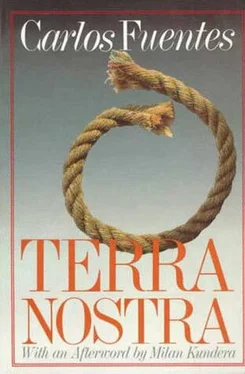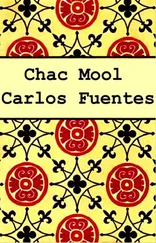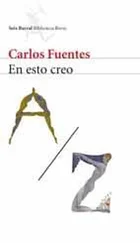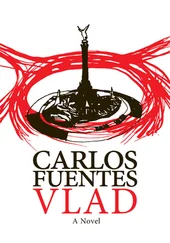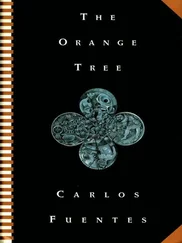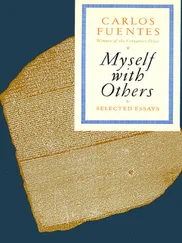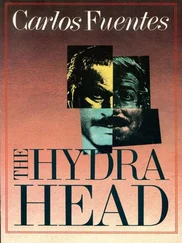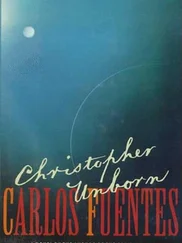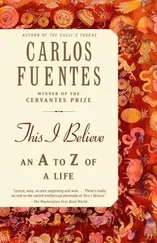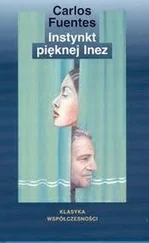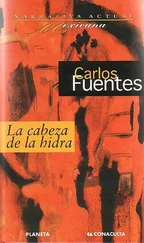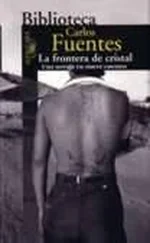Celestina had no time to respond. The armed cavaliers rushed toward the cloaked man and he, tossing his cape over his shoulder, arose and unsheathed his sword. Steel clashed against steel; the cavalier of the cape battled with joyful fervor against his rivals, and in spite of his wounded leg held them at bay. Celestina turned to reviving the nun; she succeeded in getting her to her feet, and, supporting her, led her to a hidden lane not far from the scene of the duel, where the nun again fell to the ground; close by, they could hear the shouted insults, the cry of the vanquished, the hurrahs of the victors. Celestina watched the two men with bloody swords run by, down the wider street, away from the arbor roofed by ivy reaching out from the garden on either side and clasping gnarled fingers above the heads of Celestina and the nun.
“Go, go to him,” sighed the nun, “see if they have killed him.”
Celestina ran to the site of the duel, where the abductor lay bleeding. A scarlet rosebud bloomed upon the brocade of his breast. Celestina knelt beside the dying man, not knowing exactly what to do: the cavalier of dark beauty looked at her through half-closed eyes, smiled, and managed to say: “Celestina … Celestina … Is it you, you are young again? Oh, Mother, that I meet you again only as I am again dying … I who saw you die before … oh, God, oh, Death, have I not always said … so distant a challenge…!”
And so speaking, he died. Terrified, Celestina ran from the body back to the nun hidden in the shadowy lane. Dead leaves were falling upon her white habit. She asked Celestina the outcome of the duel and the fate of the cavalier, and Celestina said: “He died.”
The nun did not weep, but merely sat there beneath the dense ivy bower of that path, with a strange expression in her eyes; finally she said: “He murdered my father for love of me. I loved my father’s murderer. My love for the living was greater than my love for the dead. He did not come to deceive me, but my father, buried here in this very convent. He came to mock the sepulcher, to challenge the statue of my father; he invited him to dine this very night at the inn, he refused my pleas to take me with him again, he said he spent only a few days with each woman he loved, one to fall in love with her, another to win her, another to abandon her, one more to find another in her place, and one hour to forget her; I pleaded; he refused; my brothers entered, they challenged him, he laughed; he seized me and fled with me, not for love of me, but to defy my brothers. He scaled the convent wall, we fell, I fainted. He died.”
The nun toyed with the dead leaves. “I saw my father’s statue tremble, the stone come to life. He would have gone to the rendezvous, I am sure. Now you see, little sad-eyed girl, how nothing has ended as I planned it, but instead in a squalid back-alley duel. Please help me, take me to the door of the convent. My honor is saved. But not my love. Do you know something, child? The worst of it all is that my fancy is still unsatisfied. Don Juan should not have died this way … Perhaps in another life. Come, help me, please take me to the convent door.”
TWO SPEAK OF THREE
Ludovico said he believed he understood some part of what he had read and translated, but now he asked the aged doctor with the black robes and with the star upon his breast for an hour of conversation, because for the moment the student could go no further without the vital juices of dialogue, which animates thought and wrests it from the inert page.
“I am listening,” the aged man said.
“Your texts honor the number 3, but your star is inscribed with the number 2…”
“Which once was one.”
“Do two deny one?”
“Only relatively. Duality diminishes unity. But it denies it absolutely only if the duality is definitive. Two eternally opposite terms could not ever combine their action for a common effect. Pure duality, should it exist, would be an irreversible severance of the continuity of things; it would be the negation of cosmic unity; it would open an eternal abyss between the two parts, and this opposition would merit the epithets of sterile, inactive, static. Evil would have triumphed.”
“Have I read correctly? Can only the third term reanimate inert duality?”
“You have read well. Binaries differentiate. Ternaries activate. Unity confers latent individuality. Duality is severing and unchanging differentiation. A trinity, as it activates the encounter between opposites, is the perfect manifestation of unity. It combines the active with the passive, it unites the feminine principle with the masculine. Three is the being that lives. What would God and the Devil do without a third, except confront one another, immobile, throughout an endless night? Good and evil: man activates them, for God and the Devil are in contention for man.”
“This morning I was translating the Cabalist, ibn-Gabirol, and he says: ‘Unity is not the root of totality, for Unity is but one form and totality is both form and matter; three is the unity of totality, that is to say that Unity represents form, and the number 2, matter.’”
“The sage speaks wisely, for three is the creative number, and without it form and matter would be inert. Nothing develops without the intervention of a third factor; without three, everything would remain forever in static polarity. Youth and old age require a middle age; past and future, the present; sensation and awareness, memory; sum and remainder, substitution. Two equal quantities in themselves are equal only by comparison to a third quantity. The intelligences of form and matter are joined and ordered in the number 3. Beginning from that number, man is armed to confront the world, and life. But he is alone.”
“What follows 3?”
“Four is nature, the cycle of constant repetitions: four seasons, four elements. Five is the first circular number: the number of the creature who has five senses, and who enclosed within a circle forms a pentagram, the five points his head, his hands, and his feet: it is the hand of the prophet Mohammed. Six is 2 times 3, perfection of the form and matter incarnate in man: beauty, justice, balance. Seven is man along his way, fate, the progression of life, for as the wise Hindu of the Atharva-Veda says, ‘Time moves upon seven wheels.’ Eight is liberation, health, the state of well-being resulting from the progression of seven: eight are the ways of Gautama Buddha, the eight rules for emerging from the river of reincarnations and touching the shore of Nirvana. Nevertheless, few are those who achieve such beatitude, and the number 9 signifies redemption and the reintegration of all things upon the threshold of unity: Nirvana is not the final point of human evolution, for he who has reached Nirvana must, in an act of enormous charity and in solidarity with a multitude of suffering creatures, renounce his personality to aid in the work of universal redemption. Such perfection is reached at the number 10: unity truly realized is the collective being, common good. All is for all; nothing is for one; the creature returns to the first Unity of the Ancient of ancients and the Unknown of the unknown: praised be His name!”
“Is there anything beyond that reunion?”
“The number 11, which, as St. Augustine of Hippo wisely said, is the arsenal of sin. Ten closes the great circle of creation and life, redemption and reunion. In eleven there is one small unity, a miserable one opposing divine unity: Lucifer. Eleven is temptation; having everything, we desire more. The multiples of eleven only accentuate this evil and this misfortune; twenty-two, thirty-three, forty-four, fifty-five, increasing dispersion, the always vaster separation between human and divine unity … Oh, my young friend: may that number never appear on the star upon my breast.”
Читать дальше
